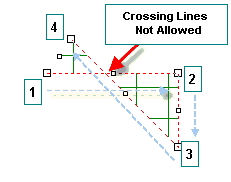Area takeoff is anything typically quantified with a 'square' measurement. Building objects such as carpeting, roofing, flooring, concrete floors, and ceiling tile are examples of construction items taken off as Areas. Square footage, volume (using the Condition's Thickness), and perimeter (lineal footage) can also be calculated. See Related articles for more information on setting up your Area Conditions.
This article is kind of long, but it's all good information. Here are a few links so you can jump around through the content:
Before
drawing any
takeoff, be sure to set and verify the Scale on each page. See Related Articles for more information on setting and verifying scale.
By default, when you draw linear and area takeoff using a mouse, On-Screen Takeoff 'snaps' to 15 degree angles and indicates when you are at 90 degrees to the previously drawn segment. These features makes taking off common corners easier, but you may not want your lines to 'snap' to a particular degree all the time.
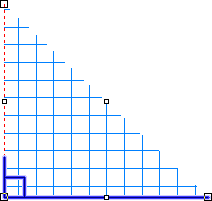
- To override "Snap Angle", hold down the <Shift> while drawing your segment. This disables Snap Angle only while <Shift> is pressed.
- To disable Snap Angle completely or to disable the Right-angle Indicator, change your settings in Tools > Options. Set the Snap Angle settings to a lower degree and disable the Right Angle Indicator - whichever you choose. See Related Articles for details on setting program and user options.
When using the Right-Angle snap to draw a takeoff object, the segments may not be exactly the same length - although the image is a square, one segment may be fractionally larger than another. This can cause calculations to be a little higher if one of the results is Visible Grid or Visible Tiles and/or if the Condition is set to round segments. See Related articles for more information on Area Conditions and rounding.
When an Area Condition is selected, hovering over a spot on the drawing automatically magnifies the region in a small pop-up box next to the cursor. This makes placing the cursor on the exact spot easier without having to zoom the page in closely.
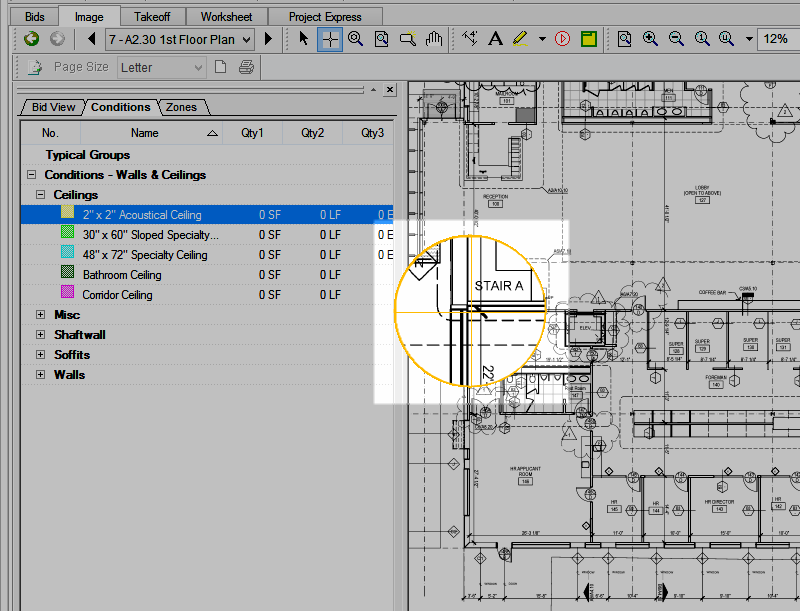
The auto-magnifying popup only displays when the page zoom level is less than the magnifier's "Default Auto Zoom Level" as set in Tools > Options.
By default, the Auto Magnifier is disabled, to enable it, open Tools > Options and set the "Default Auto Zoom Level" something other than '0'.
Drawing Area Takeoff - Click-n-Drag (Rectangles)
- Select an Area Condition from the Condition List, the cursor changes to the takeoff mode indicator

- Click the starting point, this is the anchor
- Hold down the left mouse button and drag the cursor diagonally away from the anchor point
- Release the mouse button when the area object is complete
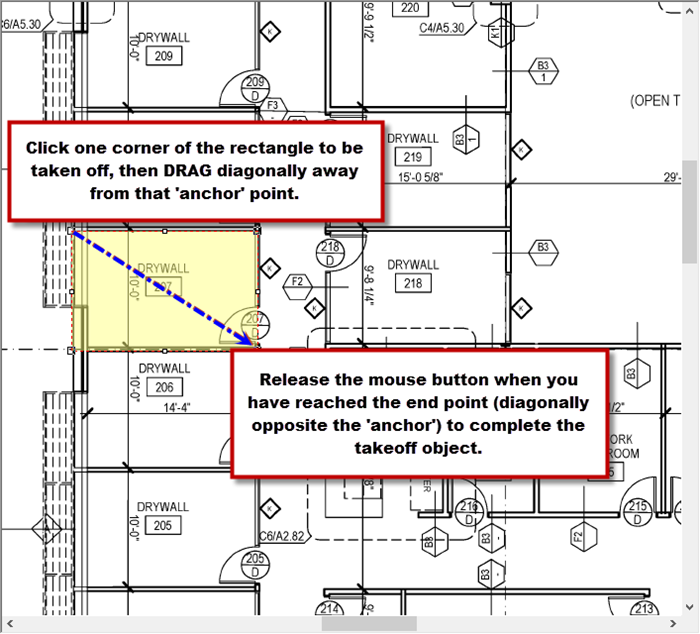
Single-Click Area
Takeoff makes it easy to
takeoff multiple rectangular areas that are not exactly the same size (when copying/pasting will not work).
Drawing Area Takeoff - Point by Point (Polygon)
To draw a polygon (something other than a simple rectangle),
- Select an Area Condition from the Condition List, the cursor changes to the takeoff mode indicator

- Click at the starting point, this is the anchor
- Click once at each corner around the desired area to takeoff
- Double-click the last point to complete the takeoff (do not try double-click at the starting point, you end up creating an "uncloseable" area)
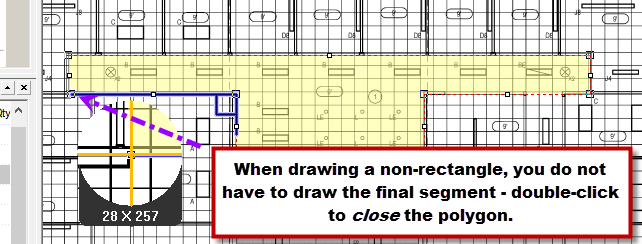
When taking off an area, it is not necessary or even advised to try draw the final segment. Just double-click at the final point and On-Screen
Takeoff connects that point with the starting point (this is called 'closing' an area
takeoff). If you try to match up the ending and starting points yourself, you may inadvertantly draw an unneeded segment or create an "unclosable area" (explained below).
Auto-Fill to Linears
If you've taken off the perimeter of a region on your plans using a Linear Condition (such as a room's walls). You can 'Auto-Fill' that closed polygon with one or more Area Conditions. The Linear Condition must be set to "Connect to" (in Condition Properties/Advanced) to use Auto-Fill.
For example,
- Draw a square room's walls using a Linear Condition where all four segments connect at the corners (using Continuous mode is the easiest way).
- Select an Area Condition
- Double-click within the room defined by the linear objects and the Area will auto-fill to fit the room.
Auto-Fill is a great way of filling in previously drawing Linear takeoff, however, you can save yourself a lot of time using On-Screen Takeoff's Patent Pending Multi-Condition Takeoff function, see Related articles for more information.
Taking off Curved Areas
To takeoff an area with curved segments, follow the contour as closely as possible using short segments. Override the Snap Angle by holding down the <Shift> key while drawing the segments or disable Snap Settings in Tools > Options.
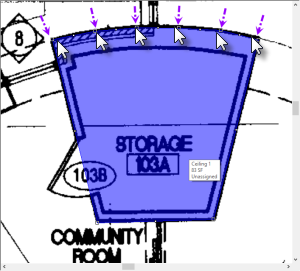
The curved area above was drawn by drawing five short, straight segments (six clicks for the curve).
Adding Vertices to an Area Segment
After you draw an area takeoff object, it may be necessary to add additional vertices (think of a vertex as a joint between two segments of an area takeoff's perimeter) to change the shape or size of the area takeoff. To add a vertex,
- Click the Select tool

- Click on the area takeoff object
- Move the cursor toward the edge of the takeoff - the cursor changes shape indicating that clicking this point adds a vertex

- Click once to add the vertex, notice that an additional vertex point appears on takeoff object
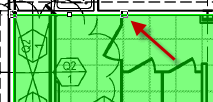
- Add as many vertices as needed (in example below, to add a 'bump-in', we need to add four vertices to the area takeoff segment).
- To move the vertex points, move the mouse pointer over the vertex and the pointer changes to the move cursor
 - indicating the vertex is ready to be moved
- indicating the vertex is ready to be moved

- Move the segments or vertices vertically or horizontally to reform the shape of the area takeoff object

Once a vertex is added, to remove it, use the Select Tool

to drag it on top of an adjacent vertex.
"Uncloseable" Areas
On-Screen Takeoff generates an unpleasant "gong" or "thunk" sound when an Unaccepted Action is performed. For example, when the program does not accept a point when you are drawing Area takeoff. When you hear this sound, return to the last accepted point by hitting the <Esc> key and then trying to click the point again (the <Esc > key backs-up the cursor position one point at a time when you are drawing area takeoff).
The most common reason for being unable to set a final point to close an Area is crossing lines as shown in the screen shot below. In this example, point 4 cannot be set because it would cause the line 3-4 to cross line 1-2 (effectively creating two area objects). It is very easy to cause this situation when completing the final segment - that is why it is recommended to allow On-Screen Takeoff to draw the final segment automatically by double-clicking the last point.
